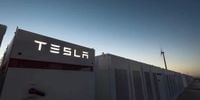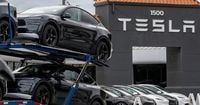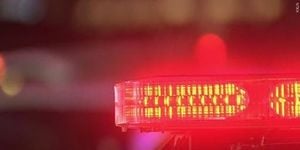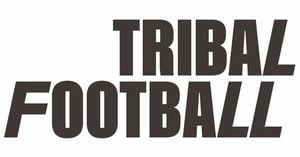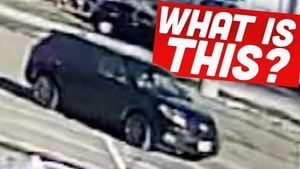Federal regulators have launched a sweeping new investigation into Tesla’s Full Self-Driving (FSD) technology after a spate of troubling incidents in which vehicles reportedly ran red lights, veered onto the wrong side of the road, and, in some cases, crashed into other cars or even caught fire. The National Highway Traffic Safety Administration (NHTSA) announced on October 10, 2025, that it is scrutinizing 58 separate reports of Teslas violating traffic laws while operating in FSD mode—a probe that now encompasses nearly every Tesla on U.S. roads equipped with the technology, totaling some 2.9 million vehicles.
According to the Associated Press, this latest probe adds to a growing list of federal investigations into Tesla’s driver-assistance technologies. The NHTSA’s filing detailed that the 58 incidents under review led to more than a dozen crashes and fires, and left nearly two dozen people injured. Particularly alarming, many drivers involved told regulators their vehicles gave no warning before behaving erratically—raising fresh questions about the reliability and safety of Tesla’s much-hyped software.
“The ultimate question is, ‘Does the software work?’” asked Seth Goldstein, a Morningstar analyst who currently rates Tesla stock as a “sell,” as quoted by the Associated Press. That question has become more urgent as Tesla CEO Elon Musk continues to tout ambitious plans for the technology. Musk, whose personal wealth is closely tied to Tesla’s stock, has publicly promised to deploy hundreds of thousands of driverless taxis in cities across the U.S. by the end of next year. For now, though, the latest investigation could throw a wrench into those plans and further complicate Tesla’s efforts to transform millions of existing vehicles into truly autonomous cars via software updates.
The NHTSA’s probe is far from the first time Tesla’s driver-assistance systems have come under regulatory scrutiny. Last year, the agency began investigating 2.4 million Teslas equipped with driver-assistance features after several accidents in poor visibility, including one that killed a pedestrian. Earlier in 2025, the NHTSA also opened a separate investigation into Tesla’s “summon” feature, which allows owners to remotely direct their cars to pick them up—following multiple reports of fender benders in parking lots. And in August 2025, yet another investigation was launched to determine why Tesla had apparently failed to promptly report crashes as required by law.
That same month, a Miami jury found Tesla partly responsible for a fatal 2019 crash involving its Autopilot driver-assist technology—a system distinct from FSD—and ordered the company to pay over $240 million in damages. Tesla has stated it will appeal the decision, but the ruling nonetheless underscored the legal risks the automaker faces as it pushes the boundaries of automated driving. According to CNN, the verdict marked a significant moment for Tesla, with the court holding the company accountable for how it markets and manages its driver-assistance systems.
Despite the repeated regulatory warnings and mounting legal challenges, Tesla insists it has always made clear that FSD is not a fully autonomous system. The company has argued in both regulatory filings and court cases that drivers are repeatedly warned they must remain attentive and ready to intervene at any time. Nonetheless, the name “Full Self-Driving” has drawn criticism for misleading consumers into believing the technology is more capable than it actually is. As the Associated Press reports, FSD is officially classified as a Level 2 driver-assistance system—meaning it can handle some driving tasks but still requires the human driver’s full attention.
Money manager Ross Gerber, a longtime Tesla investor, has emerged as a vocal critic of the company’s current approach. “The world has become a giant testing ground for Elon’s concept of full self-driving, and it’s not working,” Gerber told the Associated Press. He went further, arguing Tesla should stop calling the system “full self-driving” and admit that its vision-only approach—relying solely on cameras—needs to be augmented with radar sensors and other hardware. “They have to take responsibility for the fact that the software doesn’t work right and either adjust the hardware accordingly—and Elon can just deal with his ego issues—or somebody is gonna have to come in and say, ‘Hey, you keep causing accidents with this stuff and maybe you should just put it on test tracks until it works,’” Gerber said.
In a bid to address ongoing concerns and perhaps regain investor confidence, Tesla introduced a new version of its FSD software earlier this week. The company is also testing a dramatically upgraded version that, in theory, would not require driver intervention at all—a feature Musk has been promising for years but has yet to deliver at scale. Whether these software updates will satisfy regulators or the public remains to be seen.
Meanwhile, Tesla’s core business of selling cars is facing headwinds. Sales have slumped as some customers, disillusioned with Musk’s outspoken political stances—including his support for President Donald Trump and far-right candidates in Europe—have chosen to boycott the brand. At the same time, competition from rival electric vehicle makers, especially China’s BYD, has intensified. These competitors are luring away buyers with cheaper, high-quality alternatives, putting further pressure on Tesla’s bottom line.
In response to these challenges, Musk announced on October 7, 2025, that Tesla would start selling two new, stripped-down and more affordable versions of existing models—including its popular Model Y. Investors, however, were less than thrilled, having hoped for even lower prices or an entirely new offering. The announcement sent Tesla’s stock tumbling 4.5% on the day, according to the Associated Press. The stock had already dipped nearly 3% at one point the previous day before closing down 0.7%.
As the investigations continue, the stakes for Tesla—and for the future of autonomous vehicles—could hardly be higher. If the NHTSA finds that FSD’s flaws are systemic and pose a genuine danger to public safety, the agency could force Tesla to make sweeping changes, or even restrict the use of the technology until it meets stricter safety standards. For now, the company’s vision of a driverless future remains just that: a vision, clouded by regulatory uncertainty and mounting public skepticism.
With the eyes of both Wall Street and Main Street watching closely, Tesla faces a critical juncture. The outcome of these investigations will not only shape the company’s future but could also set the tone for the entire self-driving car industry in the years ahead.
